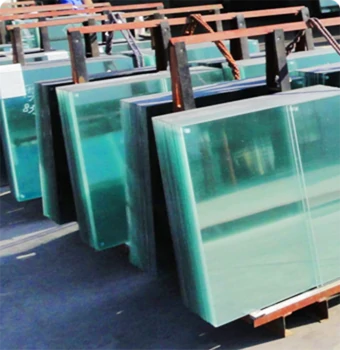The Benefits of Heat Reflective Glass in Modern Architecture
In the realm of modern architecture and construction, the materials we choose can greatly impact not only the aesthetics but also the energy efficiency of a building. One innovative solution that has gained considerable traction in recent years is heat reflective glass. This technology offers numerous benefits that extend beyond mere visual appeal, making it a vital component in the construction of contemporary structures.
Understanding Heat Reflective Glass
Heat reflective glass is a type of glazing that has been treated to reflect a significant portion of the sun's heat while still allowing natural light to enter a space. This is achieved through a special coating that is either applied to the glass or is integrated during the production process. The coating reflects infrared radiation, which constitutes the majority of the sun's heat, thereby reducing the amount of heat that enters a building. As a result, heat reflective glass helps maintain a comfortable indoor environment regardless of external weather conditions.
Energy Efficiency
One of the most compelling advantages of heat reflective glass is its contribution to energy efficiency. By minimizing solar heat gain, buildings can effectively reduce their reliance on air conditioning systems. This is particularly important in regions that experience hot climates, where cooling costs can consume a significant portion of a building's energy budget. According to studies, buildings equipped with heat reflective glass can reduce energy consumption by up to 30% during hot weather. This not only translates into lower utility bills but also contributes to a more sustainable built environment by lowering overall energy demand.
Comfort and Aesthetics
Beyond energy savings, heat reflective glass enhances the comfort of indoor spaces. By reducing glare and controlling heat gain, it creates a more pleasant atmosphere for occupants. This feature is particularly beneficial in commercial buildings, where excessive sunlight can lead to discomfort for employees and customers alike. Furthermore, heat reflective glass is available in various designs and tints, allowing architects and designers to create visually appealing facades that can complement any style. The aesthetic flexibility of this glass can enhance the overall look of a building while providing crucial functional benefits.
heat reflective glass
UV Protection
Another significant advantage of heat reflective glass is its ability to block harmful ultraviolet (UV) rays. Prolonged exposure to UV radiation can damage skin and contribute to various health issues. Additionally, UV rays can fade furniture, carpets, and artworks, leading to costly replacements and repairs. Heat reflective glass provides a protective barrier, filtering out up to 99% of these harmful rays, thereby safeguarding both the health of occupants and the integrity of interior furnishings.
Sound Insulation
In addition to its thermal and UV protective properties, heat reflective glass often exhibits sound insulation capabilities. Modern urban environments can be noisy, with traffic, construction, and other disturbances affecting the comfort of inhabitants. Heat reflective glass can help mitigate exterior noise, making buildings quieter and more conducive to work and relaxation. This acoustic advantage enhances the overall living and working experience, making properties with this type of glazing more desirable.
Environmental Impact
Choosing heat reflective glass also aligns with broader environmental goals. By reducing energy consumption in buildings, it helps to lower greenhouse gas emissions associated with energy production. As more architects and construction firms strive for LEED certification and other sustainability accolades, incorporating heat reflective glass becomes a strategic choice to demonstrate commitment to environmental stewardship.
Conclusion
In conclusion, heat reflective glass stands out as an exemplary material in modern architecture, offering a suite of benefits that enhance comfort, energy efficiency, and aesthetics. With its ability to reduce solar heat gain, block UV rays, provide sound insulation, and contribute to environmental sustainability, it is no surprise that this technology is becoming a preferred choice amongst architects and builders. As the demand for innovative and energy-efficient building solutions continues to rise, heat reflective glass will undoubtedly play a crucial role in shaping the future of construction. Whether for commercial or residential spaces, adopting this technology can lead to smarter, healthier, and more sustainable living environments.
 Afrikaans
Afrikaans  Albanian
Albanian  Amharic
Amharic  Arabic
Arabic  Armenian
Armenian  Azerbaijani
Azerbaijani  Basque
Basque  Belarusian
Belarusian  Bengali
Bengali  Bosnian
Bosnian  Bulgarian
Bulgarian  Catalan
Catalan  Cebuano
Cebuano  Corsican
Corsican  Croatian
Croatian  Czech
Czech  Danish
Danish  Dutch
Dutch  English
English  Esperanto
Esperanto  Estonian
Estonian  Finnish
Finnish  French
French  Frisian
Frisian  Galician
Galician  Georgian
Georgian  German
German  Greek
Greek  Gujarati
Gujarati  Haitian Creole
Haitian Creole  hausa
hausa  hawaiian
hawaiian  Hebrew
Hebrew  Hindi
Hindi  Miao
Miao  Hungarian
Hungarian  Icelandic
Icelandic  igbo
igbo  Indonesian
Indonesian  irish
irish  Italian
Italian  Japanese
Japanese  Javanese
Javanese  Kannada
Kannada  kazakh
kazakh  Khmer
Khmer  Rwandese
Rwandese  Korean
Korean  Kurdish
Kurdish  Kyrgyz
Kyrgyz  Lao
Lao  Latin
Latin  Latvian
Latvian  Lithuanian
Lithuanian  Luxembourgish
Luxembourgish  Macedonian
Macedonian  Malgashi
Malgashi  Malay
Malay  Malayalam
Malayalam  Maltese
Maltese  Maori
Maori  Marathi
Marathi  Mongolian
Mongolian  Myanmar
Myanmar  Nepali
Nepali  Norwegian
Norwegian  Norwegian
Norwegian  Occitan
Occitan  Pashto
Pashto  Persian
Persian  Polish
Polish  Portuguese
Portuguese  Punjabi
Punjabi  Romanian
Romanian  Russian
Russian  Samoan
Samoan  Scottish Gaelic
Scottish Gaelic  Serbian
Serbian  Sesotho
Sesotho  Shona
Shona  Sindhi
Sindhi  Sinhala
Sinhala  Slovak
Slovak  Slovenian
Slovenian  Somali
Somali  Spanish
Spanish  Sundanese
Sundanese  Swahili
Swahili  Swedish
Swedish  Tagalog
Tagalog  Tajik
Tajik  Tamil
Tamil  Tatar
Tatar  Telugu
Telugu  Thai
Thai  Turkish
Turkish  Turkmen
Turkmen  Ukrainian
Ukrainian  Urdu
Urdu  Uighur
Uighur  Uzbek
Uzbek  Vietnamese
Vietnamese  Welsh
Welsh  Bantu
Bantu  Yiddish
Yiddish  Yoruba
Yoruba  Zulu
Zulu 

